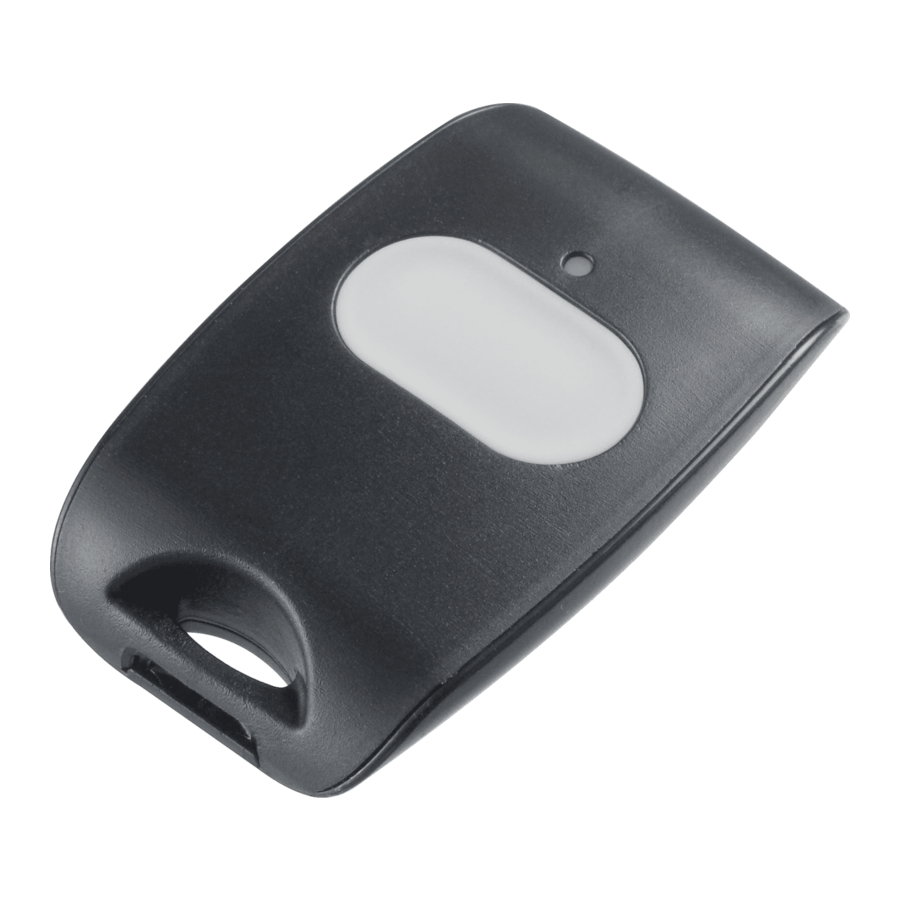
DSC PG9938, PG8938, PG4938 - PowerG Panic Button Manual
- Installation instruction (4 pages)
Advertisement

Safety
CHOKING HAZARD!
Small parts. The pendant and belt clip are NOT for children under 3 years.
Do not submerge the wireless key in any liquid as it will damage the electronic circuits.
Keep this manual for future reference.
Operation
The PG9938/PG8938/PG4938 is a panic button. Confirmation of a successful transmission is indicated by the LED light.
Device Setup
Enrollment

Refer to the PowerSeries Neo Host Installation Manual or iotega Reference Manual for the enrollment procedure.
Configuration
The following programmable option is available:
Supervision - Default [OFF]
Enables supervision of the device.
Assembly
Attaching to a Belt Clip
- Slide the device into the holder until you feel it snap securely inside.
- To attach the belt clip, slide it onto the rails on the rear of the holder.
Mounting
- Align the holder on a wall facing up as illustrated.
- Using two #4 5/8" screws and appropriate wall anchors, secure the holder to the wall.
![DSC - PG9938 - Mounting Mounting]()
- Slide the device into the holder until you feel it snap securely inside.
- To remove the device from the holder, pinch the clasps.
Maintenance
Modifications to this device not expressly approved by the party responsible for compliance may void the user's authority to operate it.
Replacing the Battery
The required battery is CR2032 Lithium 3V, manufactured by VARTA or Energizer, purchased from a DSC-approved supplier. When this panic button is out of use, remove the battery and dispose of them separately. Bring electrical appliances to the local collecting points for waste electrical and electronic equipment. Batteries are harmful to the environment, please help to protect the environment from health risks.
Replace the battery at least once every 5 years, or upon observing that the LED flickers when transmitting.
The polarity of the battery must be observed. Improper handling of lithium batteries may result in heat generation, explosion or fire, which may lead to personal injuries.
Replace only with the same or equivalent type recommended by the manufacturer. Keep away from small children. If batteries are swallowed, promptly see a doctor. Do not try to recharge these batteries. Disposal of used batteries must be made in accordance with the waste recovery and recycling regulations in your area.
To replace the battery:
- Insert a coin into the slot on the bottom of the unit and twist it open.
NOTE: Make sure the elastic pad within the cover remains in place. Put it back in place if it falls off. - Extract the old battery from its holder, and replace it with a recommended new battery. Ensure that the plus side of the battery faces up, attaining correct polarity.
![DSC - PG9938 - Replacing the Battery Replacing the Battery]()
- Test the device by pressing the button. The LED indicator should light.
- Replace the cover securely, verifying it snaps shut.
Cleaning
Abrasives of any kind and solvents such as kerosene, acetone or thinner must not be used.
Clean the wireless key only with a soft cloth or sponge moistened lightly with a mixture of water and mild detergent. Wipe dry immediately.
Testing
Always test the system at least once a year.
- Ensure the device is enrolled in the system.
- Put the alarm system into Placement Test mode.
- Stand 3 m (10 ft) away from the control panel and press the button. Verify that the transmit LED lights and the control panel responds as programmed.
- Operate the pendant from various locations within the area covered by the receiver to determine "dead" locations, where transmission is blocked by walls and large objects, or affected by structural materials.
NOTE: If dead/marginal zones are a problem, relocating the receiver may improve the performance.
Specifications
Frequency Band (MHz): CE Listed PG4938: 433- 434.72MHz; CE listed PG8938: 868-869.15MHz; FCC/IC/UL/ ULC listed PG9938: 912-919.185MHz
Communication Protocol: PowerG
Battery type: For UL/ULC listed installation use only Varta or Energizer 3V CR-2032 Lithium battery consumer grade. 230mA
Battery Life Expectancy: 5 years (not verified by UL/ULC)
Quiescent Current: 3μA
Low Battery Threshold: 2.05 V
Note: If transmission is still possible despite the battery condition, the unit will send a low battery signal to the control panel.
Temperature Range: -10°C to +55°C (UL/ULC only verified the range 0º to 49ºC)
Humidity: up to max. 93%RH, non-condensing
Dimensions (LxWxD): 53 x 33 x 11 mm (2.1 x 1.3 x 0.43 in)
Weight: 15 g (0.5 oz)
Weight (including battery): 20 g (0.7 oz)
Note: To be used in non-hazardous locations only. This equipment is designed and listed for use in security system applications only, not for health care signaling or life safety applications.
Compatible Receivers
This device can be used with DSC panels and receivers that use PowerG technology.
For UL / ULC installations use these device only in conjunction with DSC wireless receivers: WS900-19, WS900-29, HSM2HOST9, HS2LCDRF(P)9, HS2ICNRF(P)9 and PG9920. After installation, verify product functionality in conjunction with the compatible receiver used.
NOTE: Only devices operating in band 912-919MHz are UL/ ULC listed.

Documents / ResourcesDownload manual
Here you can download full pdf version of manual, it may contain additional safety instructions, warranty information, FCC rules, etc.
Download DSC PG9938, PG8938, PG4938 - PowerG Panic Button Manual
Advertisement


















Need help?
Do you have a question about the PG9938 and is the answer not in the manual?
Questions and answers